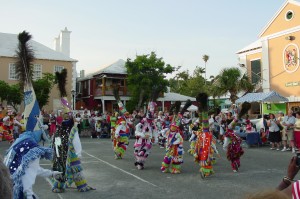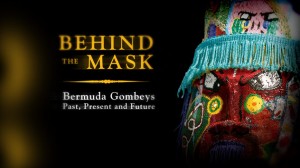The Beat Goes On For Our Gombeys
 In a particularly memorable demonstration of Christmas season humbuggery, in 1837 the “Bermuda Gazette” thundered against the island’s Gombey dancers: “We fully agree with our correspondent that the savage and nonsensical exhibition of the Gumba, practiced here by the idle, should be done away with, as a thing not suited to a civilised Community, and highly dangerous to Passengers on horses or in carriages.”
In a particularly memorable demonstration of Christmas season humbuggery, in 1837 the “Bermuda Gazette” thundered against the island’s Gombey dancers: “We fully agree with our correspondent that the savage and nonsensical exhibition of the Gumba, practiced here by the idle, should be done away with, as a thing not suited to a civilised Community, and highly dangerous to Passengers on horses or in carriages.”
Fortunately, history was deaf to the “Gazette’s” appeal.
Drummers, troubadours, storytellers-in-motion, while Bermuda’s Gombey tradition includes elements of Bahamian Goombay and African-American Mummery the unique cultural cross-pollination of Caribbean, British and Native American elements could only have occurred here.
“The Gombeys have enjoyed a remarkable shift in social status,” writer, educator and musician Ronald Lightbourne said in an appreciation of the Bermuda dance troupes written for the Smithsonian Institution’s Centre for Folklife and Cultural Heritage. “Once marginalised by polite society, they now take pride of place as icons of Bermuda’s culture. Their images appear on postage stamps, our poets have praised them, the National Dance Company of Bermuda has performed work based on their dances, and sculptors have depicted them.
” … At the invitation of the Bermuda Government, the Gombeys have even performed at a world financial conference in Davos, Switzerland—quite a change from the days when a government banned them. This change merits attention here and fuller discussion elsewhere. It indicates a shift in social and political thinking about Bermuda’s African and Caribbean connections. It also indicates the social significance of the themes they communicate.”
Bermuda’s Gombey tradition — marked by snare drum-driven rhythms inspired by British military bands, peacock-feathered headdresses and expressive dances which re-tell historical and Biblical stories in a seemingly freestlye manner which belies the intricate and disciplined choreography involved — dates back to at least the mid-18th century.
The island’s preeminent folk art, the word Gombey is thought to derive from either the Bantu word for “rhythm” or an African type of drum. Each dance is named after the legend which inspired it, and the musical accompaniment for dancers — numbering anywhere from 10 to 30 — is usually a kettle drum, two snares, a fife and keening whistles.
“In the Gombey ceremony, ‘The Captain’ leads the dance: he carries a whip and a whistle. His cape is the only one with bits of mirror and ribbons fixed to it. The ‘Wild Indian’ carries a bow and arrow. The ‘Trapper carries a rope. The ‘Chiefs’ carry tomahawks and shields while the ‘Warriors’ carry small hatchets,” recounted Afro-Caribbean historian Babacar M’Baye. “This ritual is a creolised performance in which Africans and Indian in Bermuda used pantomime and music as ways of telling a story about their resistance to European colonisation of the island. The references to weapons such as ‘tomahawk’, ‘shields’ and ‘small hatchets’ show the Native American contributions to Bermudian slave culture.”
The Gombey tradition remains at its most marked during the Christmas season but performances are also held on New Year’s Day, Easter and at other local and international festivals and celebrations. Their appeal, said Mr. Lightbourne, is immediate and infectious: “The Gombeys are lively, colourful, and rhythmic dancers … When they appear on the streets at Christmas, New Year’s Day, and certain other holidays, often accompanied by a crowd of followers, who chant in rhythm with the drummers. The appeal of their performance leads to congested streets and slowed traffic, an effect they apparently have had for years.”
Mr. Lightbourne said official disdain for Gombeys dates back to at least the middle of the 18th century, when ultimately futile measures were made to stamp out a tradition already deeply ingrained in Bermuda’s culture.
“We know that amongst the measures taken by Bermuda’s Legislature following the 1761 conspiracy to revolt was the banning of Gombey dancing,” he said. “One surmises that the government feared the decorative Gombey masks, which obscured the performer’s identity, and allowed him to escape political retribution. In the Gombey we see an archetypal Bermudian entertainer: masked, in a group, performing dances that tell stories of resistance and survival. This is so even today.”
One of the earliest surviving written accounts of the Gombeys’ Christmas activities dates from 1829. In a series of vividly drawn letters from the island collected in the book “Sketches of Bermuda”, English abolitionist Susette Lloyd recorded her impressions of pre-Emancipation Bermuda, its inhabitants and its folkways.
Generally a sympathetic observer of Bermuda’s black community, she records being woken at the Paget home where she was staying during the Christmas period because “negroes have just been dancing on the lawn ; for in this season of general festivity, they are all permitted to indulge in the wildest mirth and revelry. The oldest among them participates with the child in the delights of their Gombey … Here nature clothes them with their dusky livery, and they endeavour to heighten the eflfect by a plentiful bedaubing of red and yellow paints, scarlet doth, flowers and ribbons.”
“They completely besieged my room, which opens on the garden, so that I was forced to remain a close prisoner, and listen to their rude songs, which I should fancy must be very much like the wild yelling scream that we read of in African travels.”
Miss Lloyd clearly overcame her initial confoundment because she went on to attend two Christmas events dominated by the Gombey troupes.
“The most famous Gombey parties are those of Hamilton and Hearne (Heron) Bay,” she wrote. “They were preceded by really tolerable bands, composed of negroes dressed in a neat white uniform with scarlet facings. These musicians are all self-taught, and play many favourite airs with great accuracy. This is the more surprising, since they do not know a single note in music. They learn and play every thing by ear, and certainly have great natural taste, and love for music.”
Mr. Lightbourne said the Gombey tradition continued to thrive during the 19th and 20th centuries, even as other longstanding aspects of Bermudian culture were abandoned or forgotten — perhaps because Bermuda’s entertainers have rarely been concerned solely with entertaining. They also engage wider social issues in their music.”
Today Bermuda boasts more than half-a-dozen Gombey troupes — Warner’s Gombeys, Norford’s, the Shakey Smith Troupe, Richardson’s, Wilson’s Troupe and the all-female Alisa Kani Girl Gombeys among them. Allan Warner, captain of Warner’s Gombeys, told Mr. Lightbourne some of his troupe’s dances still celebrate the fight against oppression in Bermuda in musical and dance form.
“There are freedom dances, wherein dancers celebrate an absence of shackles and chains on the limbs,” reported Mr. Lightbourne. “Other themes he depicts as African stories are ‘Johnny and His Spear’, ‘Sampson and Delilah’, and ‘Daniel in the Lion’s Den’. Other stories depict the Hunter’s Return and pay homage to the earth and sky.”
 In 2008 Bermudian Adrian Kawaley-Lathan directed the feature-length documentary “Behind the Mask: Bermuda Gombeys Past, Present and Future”, screened at the Bermuda Internationl Film Festival and now available on DVD at the Music Box and the Bermuda Bookstore.
In 2008 Bermudian Adrian Kawaley-Lathan directed the feature-length documentary “Behind the Mask: Bermuda Gombeys Past, Present and Future”, screened at the Bermuda Internationl Film Festival and now available on DVD at the Music Box and the Bermuda Bookstore.
The director, who has a diverse background in the arts — playwriting and directing for theatre, lighting and technical work backstage, as well as vocal, dance and acting performances in Bermuda and abroad — tells an enthralling story in his 90-minute film about the evolution of this uniquely Bermudian folk art.
Featuring introductions by Bermudian Gombey historians Gary Phillips and Louise Jackson, MP, and compelling performances by various troupes, the director interviews the leaders of today’s Gombeys who trace their long roots back to earlier Gombey leaders and the social conditions which gave rise to this form of expression.
Read More About
Comments (13)
Trackback URL | Comments RSS Feed
Articles that link to this one:
- Miss Bermuda’s Gombey Costume A TV Hit : Bernews.com | November 6, 2011
- Videos Of 2012 Annual Gombey Festival In Bermuda | Bernews.com | September 24, 2012
- Videos Bermuda Gombeys on New Year's Day 2011 | Bernews.com | January 1, 2013
- Photos/Videos: PLP Hosts “Thank You Party” | Bernews.com | February 11, 2013
- Upcoming: Gombey Festival At Tennis Stadium | Bernews.com | September 4, 2013
- Video: Gombeys Make Their Boxing Day Rounds | Bernews.com | December 26, 2013
- 90 Minutes Of Video: 2014 Gombey Festival | Bernews.com | September 15, 2014


Gr8t history lesson. The first paragraph is ironic…
Enjoyed this article BERNEWS.
Nice article.
Thanks!
Very informative! Good article as usual Bernews!
To Mr. Lightbourne and Bernews. Thank You!